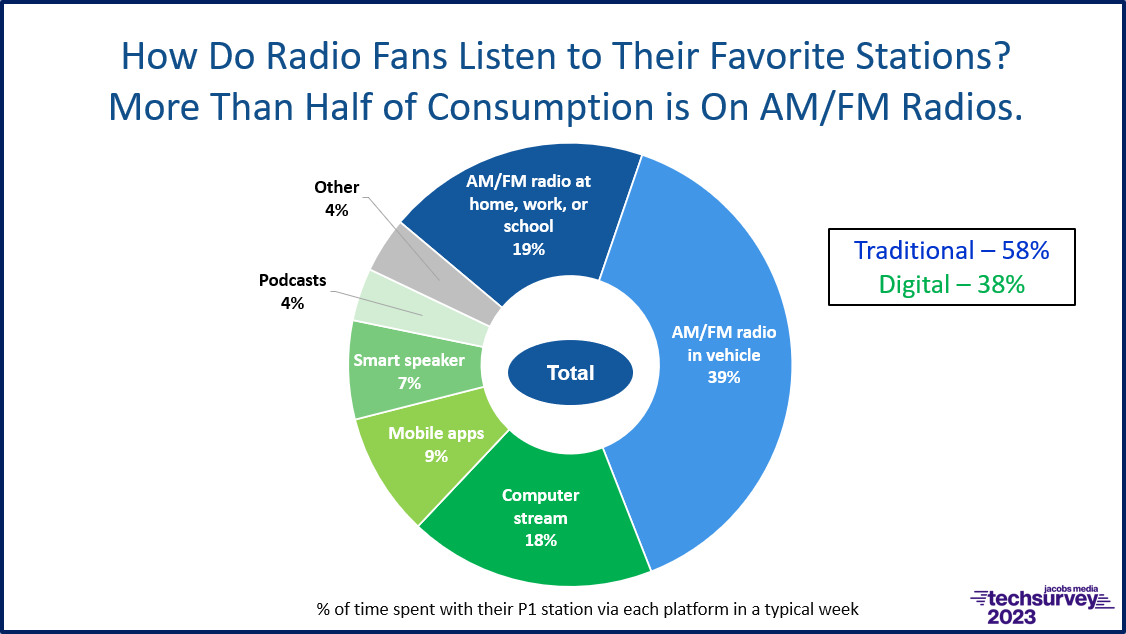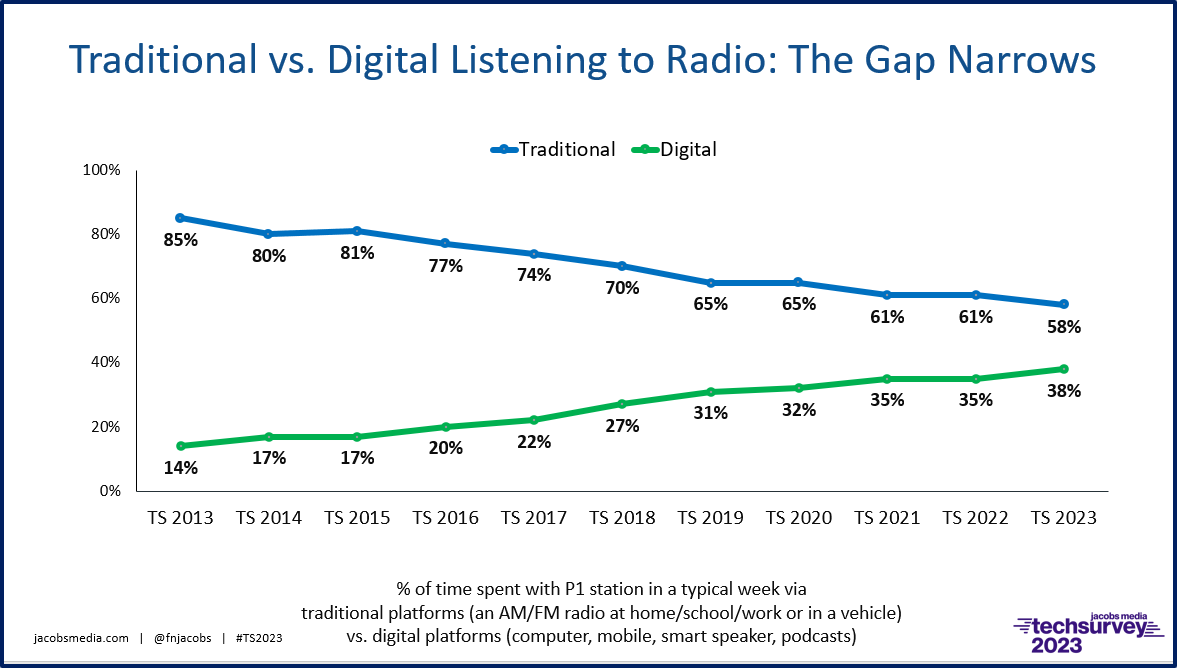
Imagine you’re not the most healthy individual, and you finally get that first physical when you’re 40 years old. Your bloodwork and other tests will produce data. Your doctor will be able to determine basic health checks.
But without physical exams taken every year, your primary care physician won’t have the perspective of tracking. Without the benefit of trending, she won’t know that your blood pressure has been alarmingly on the rise the past few years.
And so it is when we look at radio listening. This is why you’ve always heard reps from Arbitron, Nielsen, and other sensible researchers preach not only the value of trending and averaging so an odd-looking number from one research study doesn’t distort what’s really going on.
Case in point, a new study from Eastlan and FMR (both reputable firms, by the way) reported in Inside Radio provides interesting listening data that is eye-opening.
But it is in need of context.
Their study was brought to my attention by multiple radio pros who read the same article. And they were a bit surprised by the key finding:
The majority of radio listening is still happening on AM/FM radios.
The FMR/Eastlan study – on the surface – gives the appearance that broadcast radio listening on “regular radios” may be healthier than many think.
The research shows that in America’s biggest markets, two-thirds (66%) of radio listening is taking place on good old AM/FM receivers. Presumably, the remainder is being done digitally – on computers, mobile phones/apps, and smart speakers.
And that data checks out with what we saw in our own research in 2023. Our commercial radio Techsurvey showed pretty much the same thing. While a bit lower even among our core radio sample, most radio listening occurs on traditional radios in our research, too.
Our study shows that 58% of radio consumption is, in fact, taking place on AM/FM radio in cars, homes, schools, and at work. Conversely, well more than a third (38%) is being done on digital listening platforms, led by streaming on a computer.

The “blue slices” of the pie chart tell this year’s story for “regular radio” listening. When you combine AM/FM in the car (39%) with home, work, and/or school listening (19%), you come up with that 58% “traditional” number in the box on the right.
So our data is pretty consistent with FMR/Eastlan’s…except for one important “But….”
How did it look last year? Or the year before? Or pre-COVID? How has AM/FM radio listening on traditional radios trended against streaming on digital devices?
In our Techsurveys, our trending data IS the story. We’ve got 11 years of tracking. And it tells an insightful story about how consumer behavior is changing.

Yes, AM/FM is still in the lead, but the trends have dramatically moved in the digital direction. If you’re a traditional broadcaster who’s been slow to adapt, you might read the FMR/Eastland headline as a sign that perhaps the transformation away from AM/FM receivers is moving slower than the naysayers suggest. On the surface, their one-time “screen cap” of 2023 listening in major markets gives a sense “regular radio” listening is hanging in there. I’m not suggesting their data is purposely misleading because it’s not. But trending provides perspective, and most radio broadcasters need that now.
Hopefully, when FMR/Eastlan release their full report this week, they’ll go back and show you how “middle-aged radio” has been trending over the past few years. How fast has traditional radio listening fallen, and how rapid has digital consumption grown. Remember that the Techsurvey sample is comprised of mostly core radio fans who are at least proficient enough to fill out an online survey.
What does our study suggest the average broadcaster do in the face of our 11-year trend report?
It’s a clarion call to do three things:
- Meet your audience where they are – Yes, it’s becoming a cliché – because it’s TRUE. You cannot design and implement a strategy for your radio station if you don’t have a clue where your
 audience is – the media, gadgets, and platforms they use most (and least).
audience is – the media, gadgets, and platforms they use most (and least). - Be sure your digital listening platforms provide the best experience possible – How’s your station’s mobile app? (Hopefully, you have one!) Is it easy for listeners to access your stations on smart speakers? And how is the streaming experience – during music, talk, and in and out of commercial breaks? In the same way your engineer works to be sure your terrestrial signal is reliable, your station’s digital interface must be competitive.
- Market your digital touchpoints…with regularity and repetition – In most cases, you’ll need to “teach” the audience that you’re available to them digitally. On which devices are you accessible? How can the audience take you with them when they travel or are in a place where there’s no “regular radio?” How can you let them know their Amazon Alexas and Google Homes can easily tune in your station’s stream? How can you effectively communicate their mobile phone is now a portable radio, thanks to your station app? All these digital outlets need to be promoted, just like you once ran promos to encourage your listeners to make your station one of their car radio presets.
How’s broadcast radio’s health?
It depends on who you talk to, of course. Even the best data in the world will be looked at through different lenses, by individual analysts, many of whom have a dog in the hunt.
 But for you, your station, your cluster, your company, you should have sufficient data with which to draw your own conclusions. You need reliable, unvarnished data so you can make intelligent decisions about where you’ll place your bets. There’s a lot on the line – namely, financial and human resources.
But for you, your station, your cluster, your company, you should have sufficient data with which to draw your own conclusions. You need reliable, unvarnished data so you can make intelligent decisions about where you’ll place your bets. There’s a lot on the line – namely, financial and human resources.
If you’re a small broadcaster or new to the business, you should be able to see the lay of the land, to draw your own conclusions. And know that even some of the biggest radio broadcasting companies with seemingly exponential resources have made bad calls along the way, in spite of having pretty good metrics.
The devil is always in the details. But when you ask the right questions, you’re usually well on your way to getting at the truth. It’s out there, but sometimes you have to dig a bit.
And this is where you’d expect me to make a pitch for you to participate in Techsurvey 2024, going into the field in just four weeks. It’s the least expensive, most efficient way to learn these answers about your brand. How’s it looking up against other stations in your format?
If y0u’ve never participated in our Techsurveys before, you might wonder what’s the point without having trended data? And my response to you is that your trend can start with the 2024 study. If you’re consistent and diligent, that continuous stream of relevant data will be on your computer screen in just a year or two.
consistent and diligent, that continuous stream of relevant data will be on your computer screen in just a year or two.
Today’s question to better clarify how regular radio listening is holding up:
“What’s the trend on this? How does it look over time?”
And if you haven’t had a physical for a while, this might be a good week to book some quality time with that doctor of yours. A lot of disruption occurred during COVID – to radio, to your station, and maybe to you.
Get the details and sign up for Techsurvey 2024 here. If you have any questions, send me an email this week. Our signup deadline is fast approaching. – FJ
- What To Do If Your Radio Station Goes Through A Midlife Crisis - April 25, 2025
- A 2020 Lesson?It Could All Be Gone In A Flash - April 24, 2025
- How AI Can Give Radio Personalities More…PERSONALITY - April 23, 2025




I’m just here for all the “not my station” comments for digital listening by my fellow gray beards. Seriously, why do you think iHM/etc. airs all those app promos??🤔
First, great article. I still love listening to my station on analog sometimes, but because we are one of the weaker signals in town, in a very competitive rock market, the fact that we have our own clear digital app is a stand out, the rest of the stations here have to rely on iHeart or Odyssey, where as we can customize. Another bit of devils advocate, at what point are people using too much of their inventory to promote other assets, go here, go there, call over there. in reality, the only part I actually took issue with… It’s the part about the physical, I’ve been putting that off for a while, especially because I know somethings up, this wasn’t the reminder I need it at five in the morning. Lol but you’re probably right!
Have you tried to buy a radio lately? Or a bookshelf system with an AM/FM tuner? Or tried to use a newer AM radio in today’s electrical environment or an FM without an external antenna? There’s a reason why smart speakers are selling by the millions, and it ain’t the audio quality. Stations really need to pay attention to their on-air audio to make sure it’s not overcompressed and fatiguing. Most car radios these days adjust levels so you don’t have to be the loudest station on the dial to the detriment of clarity. And streaming needs to stop repeating the same commercials multiple times in the stopset. For heaven’s sake, get some eyes on those streaming and on-air logs and do both your advertisers and listeners a favor by spreading things out.
This seems to trigger more questions than solutions. First, if almost 40% of radio listening is from somewhere other than a radio, why don’t the Nielsen numbers reflect that? other than sports stations whose streams sometimes show pretty well, most station’s streams are not more than a few tenths of a point. A 5 share radio station should show close to a 2 share for its stream and a 3 for broadcast, based on the numbers presented in this column. So the question becomes whether radio stations are getting credit for all online listening – presuming that anything coming from a smart speaker, app or website should be designated as online by Nielsen. Maybe there’s an encoding issue for online streams.
Ratings aside, there is plenty of listening over the air and online, so the real issue is that in inflation adjusted dollars radio has roughly 1/3 the revenue it did in 2006 and much less audience. So is the issue whether the sound is coming from Alexa or your car radio, or the quality of that sound, regardless of how people listen to it?
Of course in a perfect world, it should matter to advertisers whether the sound is coming from your radio – or your computer, smart speaker, or TV. But alas, this is not a perfect world.
To your question about Nielsen ratings and crediting problems for streams, this is as much politics as it is technical. Not everyone has the stomach to look at radio listening numbers alongside satellite radio, streaminng, podcasts, etc.